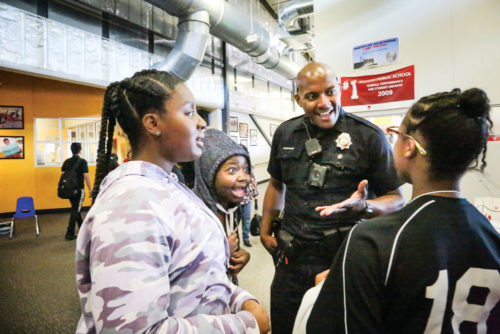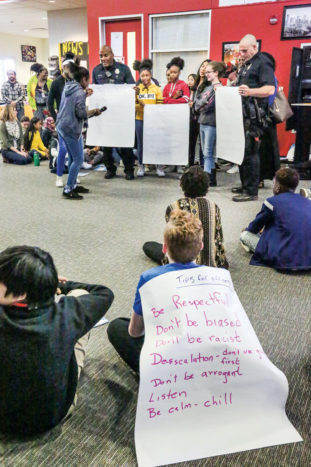
Denver Police Dept. Patrol Officer Derrick Keeton interacts with students after a workshop.
While many DPS students and teachers had October 19 off, 160 eighth graders and their faculty at the Denver School of Science and Technology: Stapleton spent the day having “brave conversations.” The local organization Brave Coalition brought together experts that “helped foster the conversations that help us work across differences and examine our own assumptions and biases,” said Principal Dan Sullivan.
Brave Coalition selected the DSST site in large part due to Sullivan’s immediate enthusiasm for the program. Sullivan stated, “One of the things I love most about our mission and our school is that we are an inclusive community; our students are of all different backgrounds, racially, ethnically, socio-economically. And we believe in the power that’s in that diversity.” DSST’s student population is about 84% minority; 69% free and reduced lunch; and 41% English language learners. The students spent the day rotating through workshops addressing issues of race, gender and bias.
Eighth grade is an especially propitious point in youth development, according to Brave Coalition’s Chris Reed, one of five Stapleton moms who established the organization in the wake of anti-Semitic and racist vandalism at Isabella Bird Community School in 2016. Good intentions are inadequate to the task of disentangling how racial biases surface in education. “To move from safe to brave” means schools and communities need to examine their privilege, she says. Although many people are uncomfortable talking about issues of bias and race, Reed says, “If you’re not feeling uncomfortable, you’re not fully in it.” She says it’s within those moments of discomfort that we have the greatest potential for growth.

Officers made lists of what kids should do and kids made lists of what officers should do. Here they are presenting their lists.
Rosetta Lee, a Seattle-based educator, led a session on gender, gender bias, conflict, and bullying. Some of the questions she wanted kids to think about were: “What is the difference between everyday conflict and bullying? What ways are boys and girls taught to experience and express aggression differently? How do identifiers like sexual orientation, race, ethnicity, ability, and socioeconomic status affect aggression?”
Representatives from Bridging the Gap: Kids and Cops led a forum on implicit bias that challenged youth to discuss their expectations and assumptions about people based on their appearance. Small groups of students each received different color photos of individuals with no further identifying characteristics. They then tried to assess the individual’s job and other personal details based on the image alone. Lively conversations ensued, and students walked away with a deeper awareness of the assumptions we all make based on external factors like dress and skin color.
The DSST students also participated in an implicit bias training session by the Kids and Cops program. Established by Denver’s Office of the Independent Monitor as part of a systemic approach to violence prevention, this program partners with the Denver Police Department and the Denver Public Schools, leading forums in which youth and police officers engage in dialogue and receive training on their rights and responsibilities.
Data provided by the Police Executive Research Forum indicates that this collaborative approach to school safety is reducing the number of behavioral incidents, out-of-school and in-school suspensions, expulsions and referrals to law enforcement. The data suggests that teaching our children to be brave and address uncomfortable truths benefits not only personal growth and development, but fosters a healthier community for us all.
Volunteer attorneys from LYRIC—Learn Your Rights in Colorado—instructed students on their Constitutional rights, and taught them proper wording, should they be approached by police. “I choose to remain silent and I want a lawyer.” “Am I free to leave?” were two key phrases. Students demonstrated the training’s relevance by raising a host of questions based on possible scenarios they as young people might face. The questions were at times poignant and revealed the range of fears and concerns our youth grapple with. “What if a teacher gives me marijuana and I don’t know it?” inquired one eighth grader, referencing the availability of edibles masquerading as sweets in Colorado.
Brave Coalition received a 2018 Race and Justice Mini-Grant from Mayor Michael Hancock’s Office of Community Affairs-Denver Human Rights and Community Partnerships in support of their efforts to bring brave conversations to the community. For more information on the Brave Coalition visit their website at www.bravecoalition.com.



0 Comments